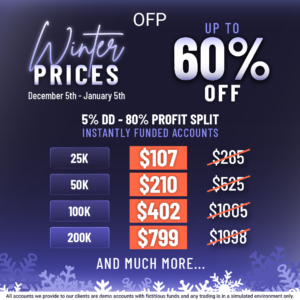Prop firms with high slippage within the world of prop firms is a crucial element that can greatly affect a trader’s profit margin and overall trading experience. Slippage is the difference between the price at which a trade is expected to be executed and the actual price that is executed; it can be caused by market volatility, order execution delays, or inefficiencies within the trading infrastructure. This article will examine the phenomenon of prop firms with high slippage, the implications it has for traders, and a review of prop firms with high slippage.
What is Slippage
Slippage is the discrepancy between a trade’s projected price and the price at which it is actually performed.
Categories of Slippage
- Positive slippage: this is the result of a trade being performed at a price higher than anticipated, which benefits the trader. Positive slippage is advantageous to the trader, for instance, if a buy order is placed at $100 and executed at $99 instead.
- Negative slippage: it occurs when a trade is executed at a lower price than anticipated. For example, a trader has negative slippage and loses money if they place a buy order at $100 but the order is executed at $101.
When there is a lot of volatility or little liquidity, slippage is more common because quick price changes can cause delays in order fulfilment. Slippage is a phenomenon that traders, particularly those involved in fast-moving markets, must comprehend.
High Slippage Effect on Trading
1. Higher Trading Expenses
Because traders may execute trades at prices that are less advantageous than expected, high slippage might result in higher trading expenses. This can reduce prospective gains and, in certain situations, result in trade losses from profitable ones. For traders who trade frequently or at high frequencies, slippage can have a significant cumulative impact.
2. A Decline in Trade Precision
Slippage compromises trade execution precision. For their plans to be implemented properly, traders rely on orders being executed at certain prices. Slippage affects the capacity to execute strategies as intended and may result in unintentional risk exposure since the execution price may vary from the expected price.
3. Effect on the Efficiency of the Strategy
High slippage can have a negative impact on some trading methods, particularly those that depend on exact entry and exit points. In the event that slippage results in variations from anticipated execution prices, strategies that rely on narrow profit margins or abrupt price swings may find it difficult to operate efficiently.
4. Elevated Risk
Slippage increases the risk associated with trading. For example, excessive slippage when executing stop-loss orders may cause the order to be filled at a price lower than intended, resulting in larger losses than expected. A trader’s overall risk management plan and capital preservation initiatives may be impacted by this elevated risk.
Factors Causing Excessive Slippage:
1. The volatility of the market
High slippage can result from market volatility, especially when there are notable price swings or news events. Prices can move quickly in erratic markets, and a widening gap between ask and bid prices can cause slippage when orders are filled at less advantageous prices.
2. Lateness in Execution
Particularly in businesses with underdeveloped IT infrastructure or slower order processing systems, execution delays can be a factor in slippage. Orders may be filled at prices other than those originally stated if trade orders are not transmitted to the market in a timely manner.
3. Problems with Cash
A low liquidity level may make slippage worse. Large orders or transactions have the potential to dramatically affect market pricing in markets with low trading activity, deviating the execution price from the expected price. Prop firms may encounter more slippage if they operate in less liquid markets.
4. Technological Restrictions
Businesses that use antiquated or ineffective trading platforms may experience significant slippage. The precision and speed of order execution are greatly influenced by technology. Businesses with inadequate infrastructure or trading systems may encounter errors and delays that lead to slippage.
Managing and Mitigating Slippage
- Choosing the Right Prop Firm: Traders can lessen the impact of slippage by researching and evaluating prop firms based on their technological infrastructure, execution speed, and liquidity offerings.
- Using Limit Orders: By defining the maximum price at which a trade will be executed, limit orders as opposed to market orders, provide greater control over execution prices and lower the risk of unfavorable slippage.
- Keeping an Eye on the Market Situation: Traders can prevent slippage by anticipating market circumstances and volatility. Preventing trading during times of elevated volatility or noteworthy news occurrences might decrease the possibility of encountering unfavorable slippage.
- Examining and Modifying Approaches: Trading techniques can be tested in a variety of market scenarios to assist traders understand how slippage may affect their results. Trading performance can be improved overall by adding risk management techniques and adjusting tactics to account for probable slippage.
- Taking Advantage of Modern Technology: Firm’s possessing cutting-edge trading technology and infrastructure might provide faster execution times and lower slippage. To reduce slippage, traders can think about utilizing trading platforms that offer real-time data, low latency execution, and sophisticated order types.
Prop Firms with High Slippage
Any trading firm may have slippage, however some proprietary trading firms are known to experience more of it because of their execution speeds, trading conditions, or market focus. Here are a few companies that traders have mentioned having a lot of slippage:
1. City Traders Imperium
Overview: A prop firm that has grown in favor with traders is City Traders Imperium. On the other hand, a few traders have complained of severe slippage, especially when dealing with less liquid pairs.
Causes of High Slippage: Slippage can be caused by the firm’s execution speeds as well as the kinds of orders that are made, particularly in markets that move quickly.
2. FundedNext
Overview: Another prop firm that lets traders trade with corporate funds is FundedNext. Even though a lot of traders like their funding strategy, slippage has been reported, especially in erratic market situations.
Causes of High Slippage: Market orders and quick price changes can cause increased slippage rates, particularly during significant news events.
3. TopTier:
Toptier has high slippage. Traders on TopTier often encounter slippage during highly volatile market conditions. The extent of slippage can vary depending on the current market situation or environment and the asset that is being traded.
Causes: Highly volatile market conditions.
4. FTMO:
Using FTMO in the night causes slippage and vice versa. FTMO traders often encounter slippage during periods of low liquidity or high market volatility
Causes: High market volatility and low liquidity.
Reasons for High Slippage
High trading slippage can be caused by a number of circumstances, including:
- Market Volatility: Prices can fluctuate quickly during periods of notable market action, such as economic announcements or geopolitical crises. Slippage may result from orders being filled at the next available price due to this volatility.
- Low Liquidity: If there aren’t enough buyers or sellers at the intended price in a market with little trading volume, slippage may result. This is especially typical during off-peak trading hours or for fewer traded currency pairs.
- Types of Orders: Unlike limit orders, which set a minimum or maximum price for execution, market orders are more prone to slippage since they are executed at the best available price. When markets are volatile, traders who use market orders may see more slippage.
Methods for Reducing Slippage
Although slippage is an inevitable aspect of trading, there are a number of tactics traders can use to lessen its effects:
- Use Limit Orders: Traders can utilize limit orders to indicate the price at which they wish to enter or exit a position, as an alternative to market orders. Though there is a chance that the order won’t be executed if the price doesn’t hit the target level, this can assist prevent negative slippage.
- Trade When There Is Liquidity: Slippage can be minimized by trading during periods of strong market liquidity, such as during important market sessions (such as those in London and New York). There are usually more participants during these times, which results in tighter spreads and better execution prices.
- Steer clear of Major News Events: Traders should exercise caution while dealing in the wake of geopolitical or economic news that could cause considerable volatility and slippage. Trading around these occasions can help reduce risk.
- Pick the Correct Prop Firm: It’s important to pick a prop firm that has a track record of quick turnaround times and minimal slippage. Finding companies that place a high priority on execution quality can be aided by investigating customer feedback and performance indicators.
Summarily,
A trader’s performance can be greatly impacted by slippage, which is an inevitable part of the game, particularly in the hectic atmosphere of proprietary trading organizations. Successful trading requires an understanding of the reasons behind slippage, the ability to identify companies with high slippage, and the application of tactics designed to reduce its effects. Traders can improve their overall trading experience and more skillfully overcome the difficulties presented by slippage by being proactive and knowledgeable.
Frequently Asked Questions
1. What does slippage mean?
- The discrepancy between a trade’s projected price and its actual execution price is known as slippage. It could be negative (worse price) or positive (better price).
2. What causes slippage?
- Slippage can be caused by a number of things, including insufficient liquidity, market versus limit order types, and the trading platform’s execution speed.
3. How can I reduce trade slippage?
- Use limit orders, trade during active market hours, steer clear of significant news events, and select a prop firm with a reputation for quick execution to reduce slippage.
4. Is slippage invariably bad?
- No, slippage is not always a bad thing. When a trade is completed at a price that is higher than anticipated, this is known as positive slippage; conversely, negative slippage happens when the execution price is lower than anticipated.
5. Is it possible to totally prevent slippage?
- Although it is impossible to totally prevent slippage, it can be reduced by utilizing cautious trading techniques including limit orders and high liquidity periods.
6. How does slippage impact my approach to trading?
- Slippage can affect profitability by raising expenses or decreasing a trading strategy’s efficacy. Comprehending slippage is vital for proficient risk mitigation.
7. Do any prop firms stand out for having a lot of slippage?
- Indeed, reports of increased slippage have been made by a few prop firms, including City Traders Imperium and FundedNext. These reports are especially relevant in times of market volatility.

















